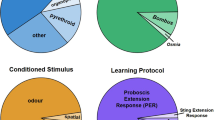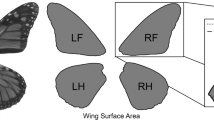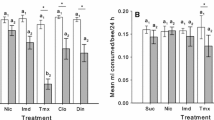Abstract
While the effects of lead pollution have been well studied in vertebrates, it is unclear to what extent lead may negatively affect insect cognition. Lead pollution in soils can elevate lead in plant tissues, suggesting it could negatively affect neural development of insect herbivores. We used the cabbage white butterfly (Pieris rapae) as a model system to study the effect of lead pollution on insect cognitive processes, which play an important role in how insects locate and handle resources. Cabbage white butterfly larvae were reared on a 4-ppm lead diet, a concentration representative of vegetation in polluted sites; we measured eye size and performance on a foraging assay in adults. Relative to controls, lead-reared butterflies did not differ in time or ability to search for a food reward associated with a less preferred color. Indeed, lead-treated butterflies were more likely to participate in the behavioral assay itself. Lead exposure did not negatively affect survival or body size, and it actually sped up development time. The effects of lead on relative eye size varied with sex: lead tended to reduce eye size in males, but increase eye size in females. These results suggest that low levels of lead pollution may have mixed effects on butterfly vision, but only minimal impacts on performance in foraging tasks, although follow-up work is needed to test whether this result is specific to cabbage whites, which are often associated with disturbed areas.





Similar content being viewed by others
References
Ali FA (1974) Structure and metamorphosis of the brain and suboesophageal ganglion of Pieris brassicae (L.) (Lepidoptera: Pieridae). Trans R Entomol Soc Lond 125:363–412
Blackiston D, Briscoe AD, Weiss MR (2011) Color vision and learning in the monarch butterfly, Danaus plexippus (Nymphalidae). J Exp Biol 214:509–520
Blumstein DT, Evans CS, Daniel JC (2006) JWatcher v. 1.0. See www.jwatcher.ucla.edu
Burden CM, Elmore C, Hladun KR et al (2016) Acute exposure to selenium disrupts associative conditioning and long-term memory recall in honey bees (Apis mellifera). Ecotoxicol Environ Saf 127:71–79
Burger J (1998) Effects of lead on sibling recognition in young herring gulls. Toxicol Sci 43:155–160
Burger J, Gochfeld M (1993) Lead and behavioral development in young herring gulls: effects of timing of exposure on individual recognition. Toxicol Sci 21:187–195
Burger J, Gochfeld M (2005) Effects of lead on learning in herring gulls: an avian wildlife model for neurobehavioral deficits. Neurotoxicology 26:615–624
Byzitter J, Lukowiak K, Karnik V, Dalesman S (2012) Acute combined exposure to heavy metals (Zn, Cd) blocks memory formation in a freshwater snail. Ecotoxicology 21:860–868
Calabrese EJ, Baldwin LA (2002) Defining hormesis. Hum Exp Toxicol 21:91–97. doi:10.1191/0960327102ht217oa
Cecil KM, Brubaker CJ, Adler CM et al (2008) Decreased brain volume in adults with childhood lead exposure. PLoS Med 5:e112
Cepero LC, Rosenwald LC, Weiss MR (2015) The relative importance of flower color and shape for the foraging monarch butterfly (Lepidoptera: Nymphalidae). J Insect Behav 28:499–511
Chittka L, Raine NE (2006) Recognition of flowers by pollinators. Curr Opin Plant Biol 9:428–435
Daneshparvar M, Jeddi MZ, Yunesian M et al (2016) The role of lead exposure on attention-deficit/hyperactivity disorder in children: a systematic review. Iran J Psychiatry 11:1–14
Datko-Williams L, Wilkie A, Richmond-Bryant J (2014) Analysis of US soil lead (Pb) studies from 1970 to 2012. Sci Total Environ 468:854–863
Dell'aglio DD, Losada ME, Jiggins CD (2016) Butterfly learning and the diversification of plant leaf shape. Front Ecol Evol 4:81
Eisler R (1988) Lead hazards to fish, wildlife, and invertebrates: a synoptic review. US Fish and Wildlife Service, Laurel
Ethier A-A, Muckle G, Bastien C et al (2012) Effects of environmental contaminant exposure on visual brain development: a prospective electrophysiological study in school-aged children. Neurotoxicology 33:1075–1085. doi:10.1016/j.neuro.2012.05.010
Feeny P, Städler E, Åhman I, Carter M (1989) Effects of plant odor on oviposition by the black swallowtail butterfly, Papilio polyxenes (Lepidoptera: Papilionidae). J Insect Behav 2(6):803–827
Finster ME, Gray KA, Binns HJ (2004) Lead levels of edibles grown in contaminated residential soils: a field survey. Sci Total Environ 320:245–257
Flora G, Gupta D, Tiwari A (2012) Toxicity of lead: a review with recent updates. Interdiscip Toxicol 5:47–58
Garza A, Vega R, Soto E (2006) Cellular mechanisms of lead neurotoxicity. Med Sci Monit 12:RA57–RA65
Gintenreiter S, Ortel J, Nopp HJ (1993a) Effects of different dietary levels of cadmium, lead, copper, and zinc on the vitality of the forest pest insect Lymantria dispar L. (Lymantriidae, Lepid). Arch Environ Contam Toxicol 25:62–66
Gintenreiter S, Ortel J, Nopp HJ (1993b) Bioaccumulation of cadmium, lead, copper, and zinc in successive developmental stages of Lymantria dispar L. (Lymantriidae, Lepid)—a life cycle study. Arch Environ Contam Toxicol 25:55–61
Goodlad JK, Marcus DK, Fulton JJ (2013) Lead and attention-deficit/hyperactivity disorder (ADHD) symptoms: a meta-analysis. Clin Psychol Rev 33:417–425
Gorissen L, Snoeijs T, Van Duyse E, Eens M (2005) Heavy metal pollution affects dawn singing behaviour in a small passerine bird. Oecologia 145:504–509
Goulson D, Cory JS (1993) Flower constancy and learning in foraging preferences of the green-veined white butterfly Pieris napi. Ecol Entomol 18:315–320
Harrison R (2012) Lead pollution: causes and control. Springer, Berlin
He T, Hirsch HVB, Ruden DM, Lnenicka GA (2009) Chronic lead exposure alters presynaptic calcium regulation and synaptic facilitation in Drosophila larvae. Neurotoxicology 30:777–784. doi:10.1016/j.neuro.2009.08.007
Heinze S, Reppert SM (2012) Anatomical basis of sun compass navigation I: the general layout of the monarch butterfly brain. J Comp Neurol 520:1599–1628
Hern A, Edwards-Jones G, McKinlay RG (1996) A review of the pre-oviposition behaviour of the small cabbage white butterfly, Pieris rapae (Lepidoptera: Pieridae). Ann Appl Biol 128:349–371
Hirsch HV, Mercer J, Sambaziotis H et al (2003) Behavioral effects of chronic exposure to low levels of lead in Drosophila melanogaster. Neurotoxicology 24:435–442
Hirsch HV, Possidente D, Averill S et al (2009) Variations at a quantitative trait locus (QTL) affect development of behavior in lead-exposed Drosophila melanogaster. Neurotoxicology 30:305–311
Hogsden KL, Hutchinson TC (2004) Butterfly assemblages along a human disturbance gradient in Ontario, Canada. Can J Zool 82:739–748
Kandori I, Ohsaki N (1996) The learning abilities of the white cabbage butterfly, Pieris rapae, foraging for flowers. Res Popul Ecol 38:111–117
Kenig B, Stamenković-Radak M, Andelković M (2013) Population specific fitness response of Drosophila subobscura to lead pollution. Insect Sci 20:245–253. doi:10.1111/j.1744-7917.2012.01501.x
Khan A, Khan S, Khan MA et al (2015) The uptake and bioaccumulation of heavy metals by food plants, their effects on plants nutrients, and associated health risk: a review. Environ Sci Pollut Res 22:13772–13799
Kim S, Arora M, Fernandez C et al (2013) Lead, mercury, and cadmium exposure and attention deficit hyperactivity disorder in children. Environ Res 126:105–110
Kocher SD, Williams EH (2000) The diversity and abundance of North American butterflies vary with habitat disturbance and geography. J Biogeogr 27:785–794
Kuester A, Conner JK, Culley T, Baucom RS (2014) How weeds emerge: a taxonomic and trait-based examination using United States data. New Phytol 202:1055–1068. doi:10.1111/nph.12698
Kusano T, Sato H (1980) The sensitivity of tarsal chemoreceptors for sugars in the cabbage butterfly, Pieris rapae crucivora Boisduval. Appl Entomol Zool 15(4):385–391
Laverty TM, Plowright RC (1988) Flower handling by bumblebees: a comparison of specialists and generalists. Anim Behav 36:733–740
Lewis AC (1986) Memory constraints and flower choice in Pieris rapae. Science 232:863–865
Luo M, Xu Y, Cai R et al (2014) Epigenetic histone modification regulates developmental lead exposure induced hyperactivity in rats. Toxicol Lett 225:78–85
Lynn SK, Cnaani J, Papaj DR (2005) Peak shift discrimination learning as a mechanism of signal evolution. Evolution 59:1300–1305
Margulies C, Tully T, Dubnau J (2005) Deconstructing memory in Drosophila. Curr Biol 15(17):R700–R713
Mason LH, Harp JP, Han DY (2014) Pb Neurotoxicity: neuropsychological effects of lead toxicity. BioMed Res Int 2014:8. doi:10.1155/2014/840547
Massadeh A, Al-Momani F, Elbetieha A (2008) Assessment of heavy metals concentrations in soil samples from the vicinity of busy roads: influence on Drosophila melanogaster life cycle. Biol Trace Elem Res 122:292–299
Mitchell RG, Spliethoff HM, Ribaudo LN et al (2014) Lead (Pb) and other metals in New York City community garden soils: factors influencing contaminant distributions. Environ Pollut 187:162–169
Morley EJ, Hirsch HVB, Hollocher K, Lnenicka GA (2003) Effects of chronic lead exposure on the neuromuscular junction in Drosophila larvae. NeuroToxicology 24:35–41. doi:10.1016/S0161-813X(02)00095-5
Ômura H, Honda K (2004) Priority of color over scent during flower visitation by adult Vanessa indica butterflies. Oecologia 142:588–596. doi:10.1007/s00442-004-1761-6
Papaj DR, Rausher MD (1987) Components of conspecific host descrimination behavior in the butterfly Battus philenor. Ecology 68:245–253
Perugini M, Manera M, Grotta L et al (2011) Heavy metal (Hg, Cr, Cd, and Pb) contamination in urban areas and wildlife reserves: honeybees as bioindicators. Biol Trace Elem Res 140:170–176
Pocock SJ, Smith M, Baghurst P (1994) Environmental lead and children’s intelligence: a systematic review of the epidemiological evidence. Br Med J 309:1189–1197
Posthuma L, Verweij RA, Widianarko B, Zonneveld C (1993) Life-history patterns in metal-adapted Collembola. Oikos 67:235–249
Rader R, Bartomeus I, Garibaldi LA et al (2016) Non-bee insects are important contributors to global crop pollination. Proc Natl Acad Sci 113:146–151
Raine NE, Chittka L (2008) The correlation of learning speed and natural foraging success in bumble-bees. Proc R Soc Lond B Biol Sci 275:803–808
Rutowski RL (2000) Variation of eye size in butterflies: inter-and intraspecific patterns. J Zool 252:187–195
Rutowski RL (2003) Visual ecology of adult butterflies. In: Boggs CL, Watt WB, Ehrlich PR (eds) Butterflies ecology and evolution taking flight. The University of Chicago Press, Chicago, IL
Rutowski RL, McCoy L, Demlong MJ (2001) Visual mate detection in a territorial male butterfly (Asterocampa leilia): effects of distance and perch location. Behaviour 138:31–43
Ruuskanen S, Eeva T, Kotitalo P et al (2015) No delayed behavioral and phenotypic responses to experimental early-life lead exposure in great tits (Parus major). Environ Sci Pollut Res 22:2610–2621
Schmidt GH, Ibrahim NMM (1994) Heavy metal content (Hg2+, Cd2+, Pb2+) in various body parts: its impact on cholinesterase activity and binding glycoproteins in the grasshopper Aiolopus thalassinus adults. Ecotoxicol Environ Saf 29:148–164. doi:10.1016/0147-6513(94)90016-7
Schwarz K, Pickett ST, Lathrop RG et al (2012) The effects of the urban built environment on the spatial distribution of lead in residential soils. Environ Pollut 163:32–39
Sivinski J (1989) Mushroom body development in nymphalid butterflies: a correlate of learning? J Insect Behav 2:277–283
Snell-Rood EC, Papaj DR (2006) Learning signals within sensory environments: does host cue learning in butterflies depend on background? Anim Biol 56:173–192
Snell-Rood EC, Papaj DR (2009) Patterns of phenotypic plasticity in common and rare environments: a study of host use and color learning in the cabbage white butterfly Pieris rapae. Am Nat 173:615–631
Snell-Rood EC, Papaj DR, Gronenberg W (2009) Brain size: a global or induced cost of learning? Brain Behav Evol 73:111–128
Snell-Rood EC, Espeset A, Boser CJ et al (2014) Anthropogenic changes in sodium affect neural and muscle development in butterflies. Proc Natl Acad Sci 111:10221–10226
Stewart WF, Schwartz BS (2007) Effects of lead on the adult brain: a 15-year exploration. Am J Ind Med 50:729–739
Stewart WF, Schwartz BS, Davatzikos C et al (2006) Past adult lead exposure is linked to neurodegeneration measured by brain MRI. Neurology 66:1476–1484
Tollett VD, Benvenutti EL, Deer LA, Rice TM (2009) Differential toxicity to Cd, Pb, and Cu in dragonfly larvae (Insecta: Odonata). Arch Environ Contam Toxicol 56:77–84
Troetschler RG, Malone CM, Bucago ER, Johnston MR (1985) System for rearing Pieris rapae (Lepidoptera: Pieridae) on a noncruciferous artificial diet developed for Manduca sexta (Lepidoptera: Sphingidae). J Econ Entomol 78:1521–1523
Weiss MR (1995) Associative colour learning in a nymphalid butterfly. Ecol Entomol 20:298–301
Weiss MR (1997) Innate colour preferences and flexible colour learning in the pipevine swallowtail. Anim Behav 53:1043–1052
Weiss MR, Papaj DR (2003) Colour learning in two behavioural contexts: how much can a butterfly keep in mind? Anim Behav 65:425–434
Wittig R, Becker U (2010) The spontaneous flora around street trees in cities: a striking example for the worldwide homogenization of the flora of urban habitats. Flora-Morphol Distrib Funct Ecol Plants 205:704–709. doi:10.1016/j.flora.2009.09.001
Worden BD, Papaj DR (2005) Flower choice copying in bumblebees. Biol Lett 1:504–507
Worden BD, Skemp AK, Papaj DR (2005) Learning in two contexts: the effects of interference and body size in bumblebees. J Exp Biol 208:2045–2053
Xian X (1989) Effect of chemical forms of cadmium, zinc, and lead in polluted soils on their uptake by cabbage plants. Plant Soil 113:257–264. doi:10.1007/BF02280189
Zhang Y, Lambiase S, Fasola M et al (2001) Mortality and tissue damage by heavy metal contamination in the German cockroach, Blattella germanica (Blattaria, Blattellidae). Ital J Zool 68:137–145
Zhang Y-F, van Loon JJA, Wang C-Z (2010) Tarsal taste neuron activity and proboscis extension reflex in response to sugars and amino acids in Helicoverpa armigera (Hübner). J Exp Biol 213:2889–2895. doi:10.1242/jeb.042705
Zhong Z, Zhang C, Rizak JD et al (2010) Chronic prenatal lead exposure impairs long-term memory in day old chicks. Neurosci Lett 476:23–26
Ziemba KS, Rutowski RL (2000) Sexual dimorphism in eye morphology in a butterfly (Asterocampa leilia; Lepidoptera, Nymphalidae). Psyche (Stuttg) 103:25–36
Acknowledgments
The authors would like to thank Meredith Steck for input on the experimental design and Eli Swanson and Sarah Jaumann for commenting on the manuscript. Input from two anonymous reviewers substantially improved this work. This study was funded by a University of Minnesota Undergraduate Research Opportunities Program Grant to KHP; the Snell-Rood lab was supported in part through NSF IOS-1354737.
Author information
Authors and Affiliations
Corresponding author
Ethics declarations
Conflict of interest
The authors declare that they have no conflict of interest.
Human animal rights
This article does not contain any studies with human participants or vertebrate animals performed by any of the authors.
Data accessibility
Data are accessible in DRYAD accession doi:10.5061/dryad.7f55p.
Additional information
This article is part of the Special Issue Animal cognition in a human dominated world.
Rights and permissions
About this article
Cite this article
Philips, K.H., Kobiela, M.E. & Snell-Rood, E.C. Developmental lead exposure has mixed effects on butterfly cognitive processes. Anim Cogn 20, 87–96 (2017). https://doi.org/10.1007/s10071-016-1029-7
Received:
Revised:
Accepted:
Published:
Issue Date:
DOI: https://doi.org/10.1007/s10071-016-1029-7




